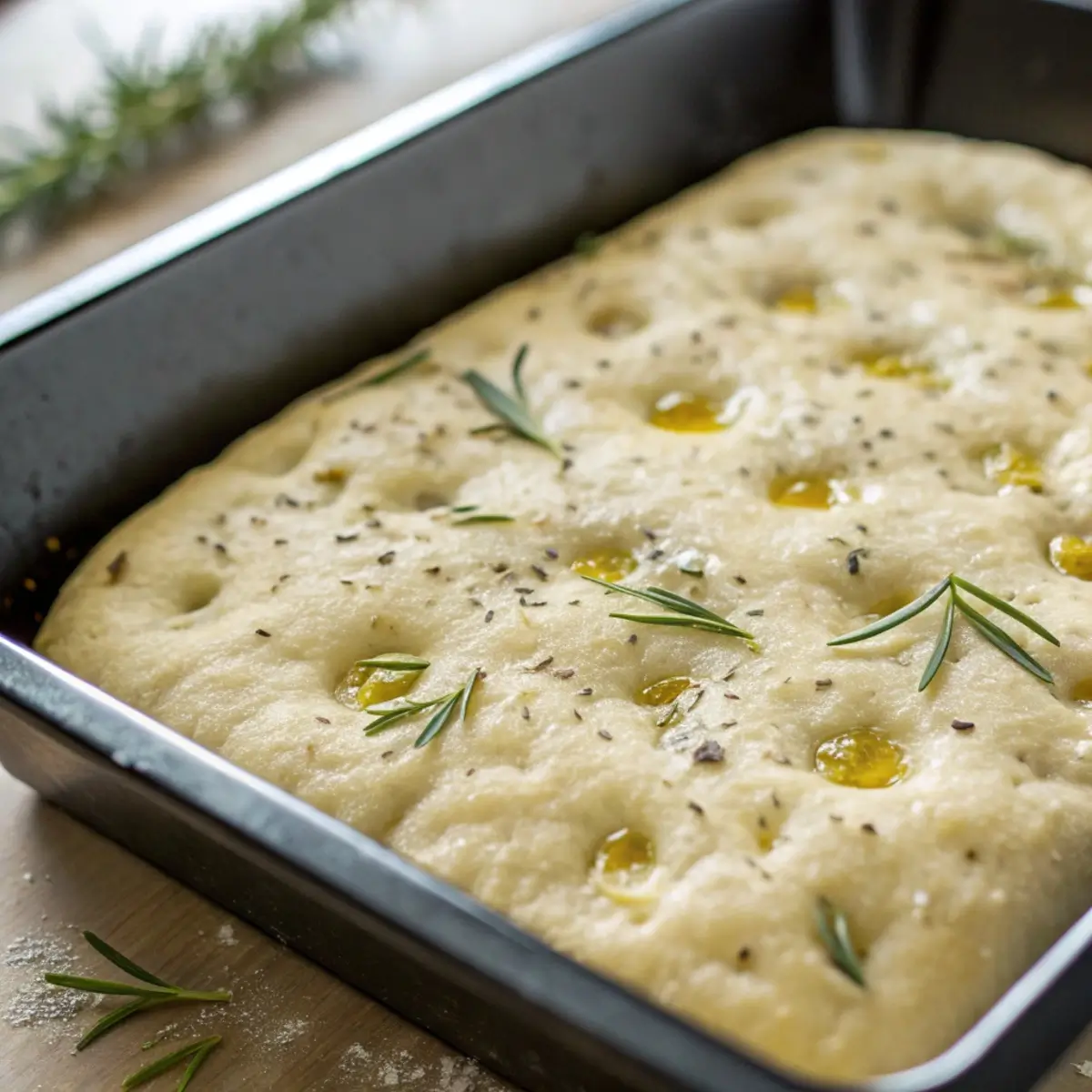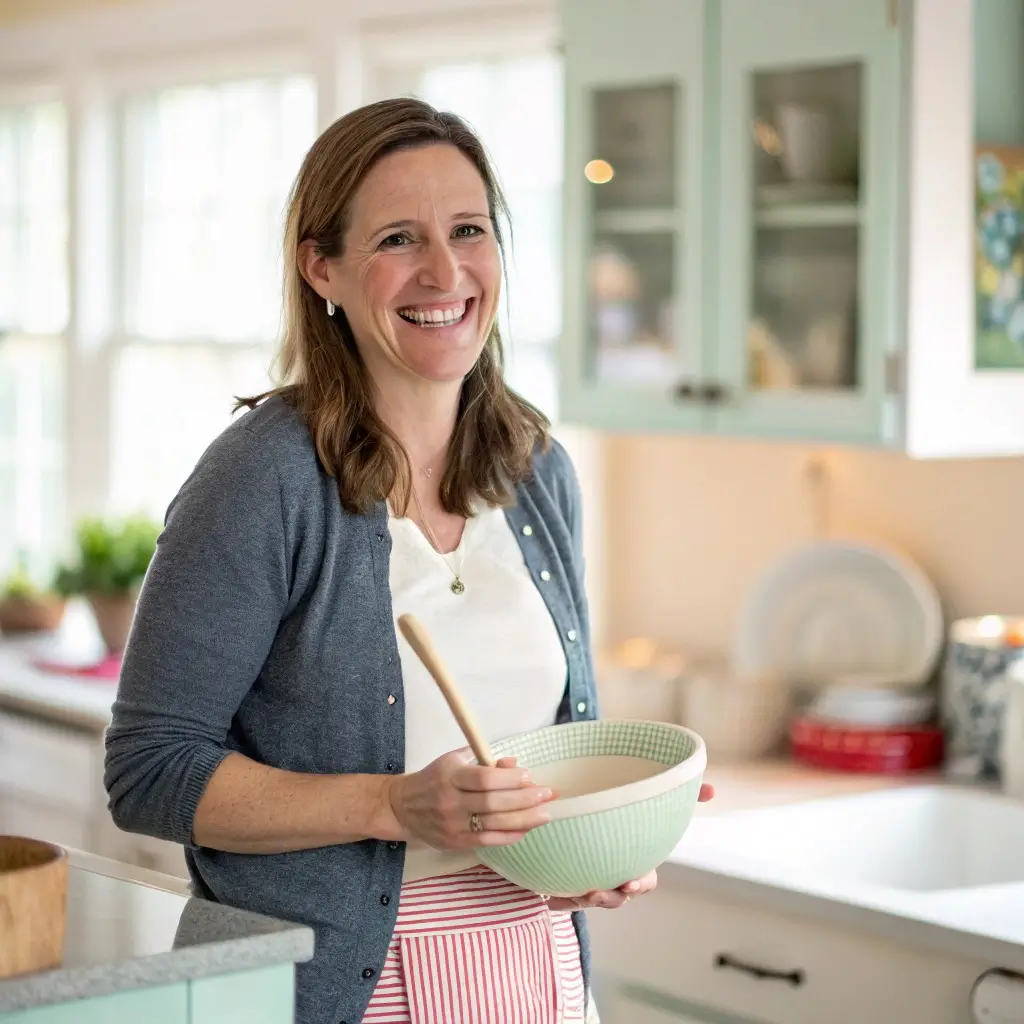There’s something magical about bread that takes its time. Overnight Sourdough Focaccia, also known as cold-rise focaccia, is a perfect example of how patience rewards the baker. This recipe transforms simple ingredients — flour, water, salt, and starter — into an aromatic, golden bread with the perfect balance of crispy crust and tender crumb.
The secret? Time. The slow, overnight fermentation in the refrigerator develops deep, complex sourdough flavor and gives the dough a light, bubbly texture that’s impossible to rush.
Unlike traditional focaccia, this recipe requires almost no effort on baking day. Just mix, rest, refrigerate, and bake. It’s ideal for holidays, weekend dinners, or any time you want fresh bread without fuss.
Whether served as a side dish with soup, dipped in olive oil, or used for sandwiches, this cold-rise sourdough focaccia is an impressive, foolproof way to bake like an artisan at home.
Why You’ll Love This Overnight Sourdough Focaccia
-
Low effort, high reward: Most of the work happens while you sleep.
-
Incredible flavor: The long fermentation enhances tang and aroma.
-
Perfect texture: Crispy edges, soft interior, and plenty of air bubbles.
-
Flexible timing: Bake the next morning or even after 24–36 hours.
-
Great for entertaining: Serve it warm and watch it disappear.
-
Beginner-friendly: No kneading, no shaping, no fancy equipment.
Ingredients You’ll Need
For the Dough:
-
500 g (about 4 cups) bread flour
-
400 g (1 2/3 cups) lukewarm water
-
100 g (1/2 cup) active sourdough starter (fed and bubbly)
-
10 g (2 tsp) fine sea salt
-
30 g (2 tbsp) extra virgin olive oil (plus more for coating and drizzling)
Optional Toppings:
-
Flaky sea salt
-
Fresh rosemary sprigs
-
Garlic-infused olive oil
-
Cherry tomatoes, olives, or caramelized onions
-
Cracked black pepper
Tools You’ll Need
-
Large mixing bowl
-
Silicone spatula or dough whisk
-
Plastic wrap or reusable cover
-
9×13-inch baking pan or cast iron skillet
-
Digital kitchen scale (highly recommended)
What Is Cold-Rise Dough?
A cold rise is a slow fermentation that happens in the refrigerator. Unlike room-temperature proofing, which can make dough rise quickly, cold fermentation develops flavor over time.
As the dough chills, natural enzymes and wild yeast in your sourdough starter continue to work slowly, creating rich, nutty, and slightly tangy notes. It also strengthens the dough, making it easier to handle and shape the next day.
This technique is common in artisan baking because it fits busy schedules — you can mix the dough one night and bake fresh focaccia the next day with minimal prep.
Step-by-Step Instructions
Step 1: Feed Your Starter
Feed your sourdough starter 6–8 hours before you start. It should be active, bubbly, and pass the float test (a small bit should float in water).
Step 2: Mix the Dough
In a large bowl, mix the active starter with water until it dissolves. Add flour and salt, and stir until all flour is absorbed and the dough forms a sticky mass.
Drizzle in 1 tablespoon of olive oil and fold it into the dough. It should look shaggy and moist — don’t worry about smoothness.
Step 3: Rest and Strengthen
Cover the bowl and let the dough rest for 30 minutes. After resting, perform one or two stretch-and-folds: grab one edge of the dough, stretch it upward, and fold it over itself. Rotate the bowl and repeat on all sides. This helps build gluten strength naturally.
Step 4: Bulk Fermentation (Room Temperature)
Let the dough sit at room temperature (about 70–75°F / 21–24°C) for 4–6 hours. You’ll know it’s ready when it has risen 50–75% in volume and has visible bubbles.
Step 5: Cold Rise (Overnight in the Fridge)
Coat the top of the dough lightly with olive oil, cover tightly, and refrigerate for 12–24 hours. The dough will continue to rise slowly, developing incredible flavor and aroma.
Step 6: Prepare the Pan
The next day, drizzle 2 tablespoons of olive oil into your baking pan. Gently transfer the cold dough into the pan, being careful not to deflate it.
Coat your hands with olive oil and press the dough gently to stretch it toward the edges. If it resists, let it rest for 10–15 minutes, then try again.
Step 7: Second Rise
Cover and let the dough rest at room temperature for 2–3 hours, until it becomes puffy and bubbly on top.
Step 8: Dimple the Dough
Preheat your oven to 425°F (220°C). With oiled fingers, make deep dimples all over the dough — push down firmly but don’t pop the bubbles.
Drizzle more olive oil over the surface and sprinkle with flaky salt and any desired toppings.
Step 9: Bake
Bake for 25–30 minutes, rotating halfway through. The focaccia is done when it’s deep golden brown and crisp around the edges.
Step 10: Cool and Serve
Let the focaccia cool in the pan for 10 minutes, then transfer it to a wire rack. Brush with olive oil for extra shine. Slice and serve warm, or let it cool completely before storing.
Pro Tips for the Best Overnight Focaccia
-
Use a metal pan for a perfectly crispy bottom.
-
Cold dough is easier to handle — don’t worry if it feels firm at first.
-
Olive oil is your friend: It prevents sticking and adds flavor.
-
Longer fermentation = deeper flavor: You can extend the cold rise up to 48 hours.
-
Let the dough come to room temperature before baking to ensure an even rise.
-
Don’t skip the dimpling: It helps prevent the dough from over-puffing and creates that classic focaccia look.
Flavor Variations
-
Rosemary Sea Salt Focaccia: Add fresh rosemary and sea salt before baking.
-
Garlic Herb Focaccia: Mix minced garlic, oregano, and thyme into olive oil for drizzling.
-
Tomato & Basil Focaccia: Press cherry tomato halves into the dough and top with basil leaves.
-
Onion & Olive Focaccia: Add caramelized onions and sliced olives.
-
Cheesy Focaccia: Sprinkle shredded mozzarella or Parmesan before baking.
Serving Ideas
This focaccia is versatile enough to complement any meal:
-
With soups: Pair with creamy tomato soup or lentil stew.
-
As an appetizer: Slice into strips and serve with olive oil and balsamic vinegar.
-
For sandwiches: Use horizontally sliced focaccia for sandwiches or panini.
-
With salads: Serve alongside Caesar salad or roasted beet salad.
-
For cheese boards: Cut into cubes for dipping in olive oil or honey.
How to Store and Reheat
Room Temperature: Store leftovers in an airtight container for up to 2 days.
Refrigerator: Keeps well for up to 5 days. Reheat before serving for best texture.
Freezer: Wrap slices individually and freeze for up to 2 months. To serve, reheat frozen slices at 375°F (190°C) for 10–15 minutes.
Reheat Tip: Lightly brush with olive oil and sprinkle a few drops of water before reheating to keep it moist.
Troubleshooting Guide
Why didn’t my dough rise overnight?
Your starter may not have been active. Always ensure it’s fed and bubbly before mixing.
Why is my focaccia dense?
The dough may have been underproofed. Allow it to fully puff up before baking.
Why is my bottom soggy?
Avoid too much oil or underbaking. A preheated metal pan can help crisp the base.
Why did my dough collapse?
It could be overproofed. Next time, bake sooner once the dough looks airy and jiggly.
Health Benefits of Sourdough Focaccia
Sourdough fermentation offers more than great taste — it’s naturally nutritious:
-
Easier to digest due to fermented gluten.
-
Lower glycemic index compared to yeast breads.
-
Enhanced mineral absorption.
-
Naturally preserved without additives.
-
Healthier gut bacteria support from natural fermentation.
Paired with antioxidant-rich olive oil, it’s a wholesome addition to any meal.
Common Mistakes to Avoid
-
Using a weak starter: The dough won’t rise properly.
-
Adding too much flour: The dough should be sticky and elastic.
-
Skipping the overnight rest: The cold rise is key to flavor.
-
Underbaking: Bake until golden and crisp.
-
Deflating the dough: Handle gently to keep air bubbles intact.
Expert Tips for Success
-
Weigh ingredients for accuracy.
-
Don’t rush fermentation — flavor takes time.
-
Use good olive oil: It’s essential to authentic focaccia flavor.
-
Chill the dough fully: At least 12 hours gives the best results.
-
Experiment with toppings: Herbs, vegetables, and salts add character.
FAQs
Can I skip the cold rise and bake the same day?
Yes, but you’ll lose the depth of flavor. Overnight fermentation is worth it!
Can I use all-purpose flour instead of bread flour?
Yes, but the texture will be slightly softer.
Do I need to knead this dough?
No. Time and hydration build the gluten naturally.
Can I bake it in a cast iron skillet?
Absolutely — it makes the crust even crispier.
Can I make this vegan?
It’s already vegan — just use plant-based olive oil and no dairy toppings.
How do I know when it’s done baking?
The top should be deeply golden, and it should sound hollow when tapped on the bottom.
Why Cold Fermentation Makes the Best Focaccia
The beauty of cold fermentation lies in flavor and flexibility. As the dough slowly ferments in the refrigerator, it develops a tangy, aromatic profile and a complex texture — chewy yet tender.
This slow process also fits seamlessly into your schedule. Mix it one night, bake the next day — perfect for busy home bakers who still want fresh, artisanal bread.
Final Thoughts
Overnight Sourdough Focaccia is proof that time and patience are a baker’s greatest tools. With minimal effort, you can create bakery-quality bread right in your kitchen — crisp on the outside, airy inside, and rich with tangy sourdough flavor.
Whether it’s part of your Christmas dinner spread, a cozy Sunday meal, or your weekly baking ritual, this focaccia is sure to impress everyone at the table.
Once you try the cold-rise method, you’ll never go back to same-day focaccia again.





